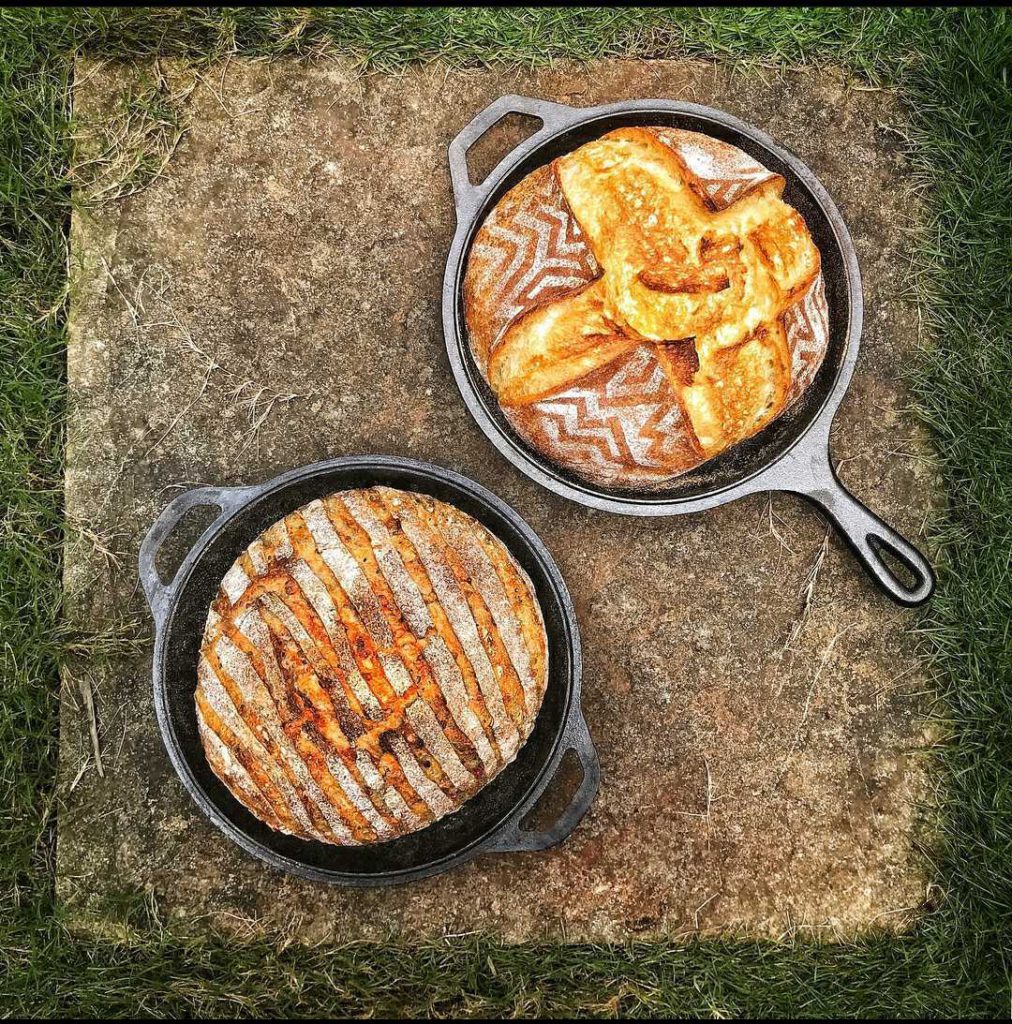Sourdough Baking Requirements

Tools and Equipment
The idea is to improvise and use whatever you can find readily. Function over form – if you may. I’m marking the ones that I consider as essential with an asterisk, but it is really up to you – to decide what’s essential and what’s not.
The list below is sequenced in the order of usage: Most are available on Amazon and in shops selling baking equipment. We have also added links to some suggested items you may purchase, but again, only the items with asterisks next to them are must-haves for the workshop, rest of the items are good to have however don’t warrant a mandatory purchase.
In line are our recommended products – Kindly note that suggested items are indicative, feel free to find an option closer to this one that suits your needs and budget.
A notebook*. Why? – To jot down formulae, processes, ambient temperature, time, and results. It could also be an e-journal. A great tool for gleaning insights from past bakes. Click here for our recommendation.
Digital scale* (capable of registering 1 gram increment). Why? – To measure everything of course. Please ensure your weighing scale is set to register grams and not ounces or pounds. Click here for our recommendation.
Wide-mouthed glass jar*. Why? – For maintaining your mother culture. Click here for our recommendation.

Danish Dough Whisk. Why? – For autolyse / fermentolyse. It can be substituted with a stiff silicon spatula, a plastic dough scraper, or even your hands. Click here for our recommendation.
Stiff Silicone Spatula. Why? – For mixing the mother starter and cleaning the sides of your mother starter jar. It can also be used for mixing the dough in the mixing bowl. Click here for our recommendation.
Large Mixing bowl*. Why? – For mixing everything. I prefer glazed ceramic or glass as they’re heavier and therefore more stable on the work area. A stainless steel bowl also works. Click here for our recommendation.
Spoons* and cups. Why? For measuring – of course.
Plastic dough scraper*. Why? – For mixing and also cleaning the sides of the mixing bowl. Click here for our recommendation.
Rock / Sea Salt* – fine grind. Why? – Why does one use salt? The normal iodised salt has lots of additives that could harm the fermentation process. Best to use untreated natural salts. These salts also have a lot of minerals that are missing from normal salt. Click here for our recommendation.
Metal Bench Scraper. Why? – For dividing the dough and/or shaping the dough, before transferring to the banneton/shaping bowl. It can be substituted by the flat part of the dough scraper. Click here for our recommendation.
Napkins*. Why? – To line the banneton/shaping bowl. I prefer one with patterns (so that the patterns can get transferred to the surface of your dough. Ta-da.
Fine rice flour*. Why? For dusting the napkins inside the banneton/shaping bowl. Click here for our recommendation.
Terracotta Tiles or unglazed tiles. (Not an essential) Why? – To line your baking tray, while using a DO (Dutch Oven). DO’s tend to be voluminous and need space and few home ovens are really large. I find that I invariably have to set the baking tray at the lowest rack and this has often led to the bottom of my loaves of bread getting singed. The terracotta tiles in the baking tray, under the DO, ensure that the bottom doesn’t singe. These can be got from any roofing tile factory. if you plan to bake on them directly, please ensure you use parchment paper as a layer between the tile and your dough. Unglazed ceramics are generally considered safe but it’s always better to be safe than sorry.
Banneton. Why? For holding the shape of the dough. It can be substituted with any shaping bowl like a colander or a plastic, glass, or steel bowl. Click here for our recommendation.

Dutch Oven* (DO). Why? To create a moist environment in which the bread is baked, and facilitate a good oven spring. A cast-iron pot works far better than a ceramic vessel. It’s especially essential in case you’re using an OTG or an Oven which doesn’t go up to 250°C of temperature. I use Lodge Cast iron dutch ovens, since they’re great quality and have always produced a superb oven spring. Click here for our recommendation.

Oven thermometer. Why? – To show what the actual temperature inside the oven in and to not blindly rely on what the oven is set to. Click here for our recommendation.
Parchment Paper*. Why? – To use as a sling in a deep Dutch Oven or when baking naked. (not to be confused with butter paper which will stick to your bread at high temperatures). Click here for our recommendation.
Oven Gloves*. Why? For protection. I prefer gloves to oven mitts as I find mitts restrictive while handling a super hot DO. Click here for our recommendation.
Lame – (the blade used for scoring). Why? To score the dough before baking. It can be replaced by a razor blade mounted on a coffee stirrer or a sharp knife or a sharp cutting tool like an Exacto Knife.
A Probe Thermometer*. Why? – Check the internal temperature of the bread without taking the bread out of the oven. Click here for our recommendation.
Cooling Rack*. Why? – To help the bread cool off. You could substitute this with the wire tray that came with your oven. Leaving a hot loaf on a flat surface will prevent heat dissipation and lead to the loaf sweating where it’s in contact with the surface, resulting in a soggy bottom. Not something you want right? Click here for our recommendation.

Bread Knife*. Why? – Because you need a sharp and serrated edge to help you slice through the crust. Click here for our recommendation.
OTG/Oven . In case you would be purchasing an oven for this kindly look for an option with an in-built fan and one that reaches an internal temperature of at least 250°C. In case you’d like to go for a relatively inexpensive option, the suggested OTG in combination with a DO works just fine. Click here for our recommendation.
Flour*. You can’t get great food without great ingredients. For the purpose of making the starter it is always advisable to use unadulterated, natural flours which have not been chemically treated and are preferably milled freshly because they tend to have a higher bio-availability of nutrients. Starters made with with whole grains ferment faster due to higher concentration of nutrients. I recommend TWF Indie for making the starter since it’s organic and has an earthy flavour. For the breads, it’s always advisable to have a high protein strong bread flour and for nutritious whole wheat breads, the only whole wheat flour that gives a good rise without any addition of maida or bread improvers is TWF Flour X. Which is also why these are also the 2 flours that go in the all inclusive package when you book your spot in my workshop.
If you have any questions about the equipment, you can voice your queries on this discussion thread – and we’ll get back to you!
You do not have permission to view this discussion.


How crucial are the Terracotta Tiles or unglazed tiles. Are there any online places they can be sourced from?
Terribly sorry for the delayed response. Terracota tiles become crucial if you’re using a Dutch Oven in an OTG. Because the DO is voluminous, it will have to be paced on the lowest rack, which means it will be very close to the heating filament and that will cause the bottom of the dough to get scorched. Got it Murali? Thanks.
Hi Anand. If you’re using an OTG, you find that the overall height sucks. This is crucial as a Dutch Oven or anything of that sort, will have to placed at the lowest rack and that will lead to the bottom of the loaf getting singed. I’d recommend you look for places that sell terracotta tiles. They will certainly have them. Make sure you buy plain, untreated tiles. Good luck.
if we dont have tiles can we use terracotta bowls
Terracotta Bowls with lids can be used but I wouldn’t recommend them as they have to be dunked in water till they stop bubbling and then they have to be heated for a while before the dough is place into them. Quite an elaborate process and the lids to the bowls that we get in India are meant for cooking and not really baking. So I guess its your call. 😊
Hi
Banneton and Danish dough whisk unavailable. 😞
As mentioned in an earlier message both are desirable and not essential. The banneton can be substituted by an oval or a circular plastic or glass dish. The Danish dough whisk can be easily substituted (details in Prerequisites for Workshop). 😊
Cast iron kadhai?
Kadhai with a flat base? And what about the lid?
Nope. Round, and lid-less 🙁
well detailed lot of tool and essentials needed
Thanks Suhasini. Not all are essential. I have make the ones that are needed with an apostrophe. 😊
The link of recommendation for the wire rack takes us to the Probe thermometer. just a correction required there. Thank you for a brilliant list. a lot of items are currently unavailable on Amazon 🙁
Hi Preeti,
Thank you for flagging that up, have fixed the issue.
All those items are indicative, please feel free to purchase the closest similar variant which suits your requirements! 🙂
Hello Guys! Have lots of queries from people asking me how they can source the desirables. Please focus on the essentials? The desirables can be sourced later? Considering that travel has become a rarity these days some of these might be difficult to source.
I clearly did not think through before I signed up – since my main baking equipment is in Bombay and I am in Goa now. Could you pls tell me specific dates that we will be baking so I can figure out if I am able to do this, else is there a possibility to join the next available course and taking a rain check on this one? By the way, most of the ‘recommendation’ links are not available on amazon.
Hey Nandan. That’s terrible , having most of your stuff in another place.The July dates for the Bake Off are 24th and 25th or 27th & 28th or 30th & 31st. The August dates are 1st & 2nd. Please share what all are available – are they the desirable ones or th essential ones?
Gonna go shopping and see what all I can find. Delfinos @ Goa, here I come.
Any recommendations on the shaping bowls that needs to be used instead of the banneton? Also the patterned napkins to line the shaping bowls?
Hello Sujit: I have a 4.07 ltrs DO and my convection oven is 60L Siemens. Quite powerful. Do I need tiles for the bread baking?
Hi Preeti, The tiles are meant to avoid the bottom of the dough burning out. If your DO base is not going to be too close to the heating elements, you don’t have to worry. Else it could be a challenge.
Sujit. I was wondering about a round cast iron kadai in place of a banner on basket. Not sure what the alternatives are. Any deep ceramic bowl?
Hello!
Thank you for reaching out. 🙂
I have moved your question to the group – Camp Sourdough’s discussion thread to ensure it grabs the attention of our Master Baker and so that all the fellow attendees can also easily access it!
You can find the discussion thread here – https://dough.twfflours.com/groups/sujit-sumitran-camp-sourdough/forum/discussion/equipment-required-for-the-workshop/
Hi, how much flour of the indie or flour x will we need?
Hi Amit. You will need a little more than a bag of Indie for making the starter. Flour X is essentially for baking bread.
Do we have to use a Dutch oven to bale bread ? Can it now go directly on the baking sheet? Also if Dutch oven is necessary then does it have to be cast iron or can it be steel too
Hi Neha,
A cast iron DO is recommended but not essential. Your call.
My mouth is watering😍😍
Why Arsha?
Nice